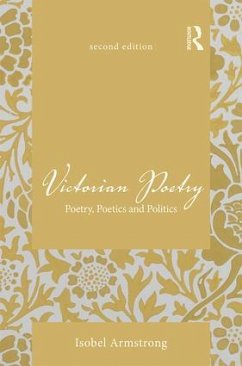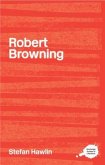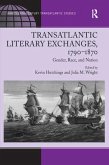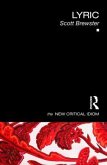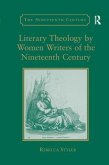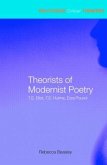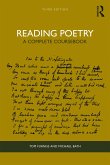- Gebundenes Buch
- Merkliste
- Auf die Merkliste
- Bewerten Bewerten
- Teilen
- Produkt teilen
- Produkterinnerung
- Produkterinnerung
In this 2nd edition of her classic work Victorian Poetry: Poetry, Poetics and Politics, Isobel Armstrong provides a new preface that notes key directions in Victorian poetry criticism, an afterword devoted to the Fin de Sià cle, and a full bibliography for the last twenty years.
Andere Kunden interessierten sich auch für
![Victorian Poetry Victorian Poetry]() Isobel ArmstrongVictorian Poetry41,99 €
Isobel ArmstrongVictorian Poetry41,99 €![Robert Browning Robert Browning]() Stefan Hawlin (University of Buckingham)Robert Browning31,99 €
Stefan Hawlin (University of Buckingham)Robert Browning31,99 €![Transatlantic Literary Exchanges, 1790-1870 Transatlantic Literary Exchanges, 1790-1870]() Julia M. WrightTransatlantic Literary Exchanges, 1790-1870190,99 €
Julia M. WrightTransatlantic Literary Exchanges, 1790-1870190,99 €![Lyric Lyric]() Scott Brewster (UK University of Salford)Lyric42,99 €
Scott Brewster (UK University of Salford)Lyric42,99 €![Literary Theology by Women Writers of the Nineteenth Century Literary Theology by Women Writers of the Nineteenth Century]() Rebecca StylerLiterary Theology by Women Writers of the Nineteenth Century56,99 €
Rebecca StylerLiterary Theology by Women Writers of the Nineteenth Century56,99 €![Theorists of Modernist Poetry Theorists of Modernist Poetry]() Rebecca Beasley (Birkbeck College, University of London, UK)Theorists of Modernist Poetry20,99 €
Rebecca Beasley (Birkbeck College, University of London, UK)Theorists of Modernist Poetry20,99 €![Reading Poetry Reading Poetry]() Tom FurnissReading Poetry38,99 €
Tom FurnissReading Poetry38,99 €-
-
-
In this 2nd edition of her classic work Victorian Poetry: Poetry, Poetics and Politics, Isobel Armstrong provides a new preface that notes key directions in Victorian poetry criticism, an afterword devoted to the Fin de Sià cle, and a full bibliography for the last twenty years.
Hinweis: Dieser Artikel kann nur an eine deutsche Lieferadresse ausgeliefert werden.
Hinweis: Dieser Artikel kann nur an eine deutsche Lieferadresse ausgeliefert werden.
Produktdetails
- Produktdetails
- Verlag: Taylor & Francis Ltd
- 2 ed
- Seitenzahl: 572
- Erscheinungstermin: 14. Februar 2019
- Englisch
- Abmessung: 240mm x 161mm x 35mm
- Gewicht: 954g
- ISBN-13: 9780415525886
- ISBN-10: 0415525888
- Artikelnr.: 40544393
- Herstellerkennzeichnung
- Libri GmbH
- Europaallee 1
- 36244 Bad Hersfeld
- gpsr@libri.de
- Verlag: Taylor & Francis Ltd
- 2 ed
- Seitenzahl: 572
- Erscheinungstermin: 14. Februar 2019
- Englisch
- Abmessung: 240mm x 161mm x 35mm
- Gewicht: 954g
- ISBN-13: 9780415525886
- ISBN-10: 0415525888
- Artikelnr.: 40544393
- Herstellerkennzeichnung
- Libri GmbH
- Europaallee 1
- 36244 Bad Hersfeld
- gpsr@libri.de
Isobel Armstrong is Emeritus Professor of English at Birkbeck College, University of London, UK.
Preface to the second edition Preface to the first edition Acknowledgements
Introduction: Re-Reading Victorian Poetry Part 1: Conservative and
Benthamite aesthetics of the avant-garde: Tennyson and Browning in the
1830s 1. Two systems of concentric circles 2. Experiments of 1830: Tennyson
and the formation of subversive conservative poetry 3. 1832: Critique of
the poetry of sensation 4. Experiments in the 1830s: Browning and the
Benthamite formation 5. The politics of dramatic form Part 2: Mid-century:
European revolution and Crimean War - democratic, liberal, radical and
feminine voices 6. Individualism under pressure 7. The radical in crisis:
Clough 8. The liberal in crisis: Arnold 9. A new radical aesthetic - the
Grotesque as cultural critique: Morris 10. Tennyson in the 1850s: new
experiments in conservative poetry and the Type 11. Browning in the 1850s
and after: new experiments in radical poetry and the Grotesque 12. 'A music
of thine own': women's poetry - an expressive tradition? Part 3: Another
culture? Another poetics? Introduction: the 1860s and after: aesthetics,
language, power and high finance 13. Swinburne: agonistic republican - the
poetry of sensation as democratic critique 14. Hopkins: agonistic
reactionary - the Grotesque as conservative form 15. Meredith and others:
hard, gem-like dissidence 16. James Thomson: atheist, blasphemer and
anarchist - the Grotesque sublime 17. Alternative fin de siecles: Rudyard
Kipling, Michael Field, Thomas Hardy and Alice Meynell Notes Indicative
bibliography
Introduction: Re-Reading Victorian Poetry Part 1: Conservative and
Benthamite aesthetics of the avant-garde: Tennyson and Browning in the
1830s 1. Two systems of concentric circles 2. Experiments of 1830: Tennyson
and the formation of subversive conservative poetry 3. 1832: Critique of
the poetry of sensation 4. Experiments in the 1830s: Browning and the
Benthamite formation 5. The politics of dramatic form Part 2: Mid-century:
European revolution and Crimean War - democratic, liberal, radical and
feminine voices 6. Individualism under pressure 7. The radical in crisis:
Clough 8. The liberal in crisis: Arnold 9. A new radical aesthetic - the
Grotesque as cultural critique: Morris 10. Tennyson in the 1850s: new
experiments in conservative poetry and the Type 11. Browning in the 1850s
and after: new experiments in radical poetry and the Grotesque 12. 'A music
of thine own': women's poetry - an expressive tradition? Part 3: Another
culture? Another poetics? Introduction: the 1860s and after: aesthetics,
language, power and high finance 13. Swinburne: agonistic republican - the
poetry of sensation as democratic critique 14. Hopkins: agonistic
reactionary - the Grotesque as conservative form 15. Meredith and others:
hard, gem-like dissidence 16. James Thomson: atheist, blasphemer and
anarchist - the Grotesque sublime 17. Alternative fin de siecles: Rudyard
Kipling, Michael Field, Thomas Hardy and Alice Meynell Notes Indicative
bibliography
Preface to the second edition Preface to the first edition Acknowledgements Introduction: Re-Reading Victorian Poetry Part 1: Conservative and Benthamite aesthetics of the avant-garde: Tennyson and Browning in the 1830s 1. Two systems of concentric circles 2. Experiments of 1830: Tennyson and the formation of subversive conservative poetry 3. 1832: Critique of the poetry of sensation 4. Experiments in the 1830s: Browning and the Benthamite formation 5. The politics of dramatic form Part 2: Mid-century: European revolution and Crimean War - democratic, liberal, radical and feminine voices 6. Individualism under pressure 7. The radical in crisis: Clough 8. The liberal in crisis: Arnold 9. A new radical aesthetic - the Grotesque as cultural critique: Morris 10. Tennyson in the 1850s: new experiments in conservative poetry and the Type 11. Browning in the 1850s and after: new experiments in radical poetry and the Grotesque 12. 'A music of thine own': women's poetry - an expressive tradition? Part 3: Another culture? Another poetics? Introduction: the 1860s and after: aesthetics, language, power and high finance 13. Swinburne: agonistic republican - the poetry of sensation as democratic critique 14. Hopkins: agonistic reactionary - the Grotesque as conservative form 15. Meredith and others: hard, gem-like dissidence 16. James Thomson: atheist, blasphemer and anarchist - the Grotesque sublime 17. Alternative fin de siecles: Rudyard Kipling, Michael Field, Thomas Hardy and Alice Meynell Notes Indicative bibliography
Preface to the second edition Preface to the first edition Acknowledgements
Introduction: Re-Reading Victorian Poetry Part 1: Conservative and
Benthamite aesthetics of the avant-garde: Tennyson and Browning in the
1830s 1. Two systems of concentric circles 2. Experiments of 1830: Tennyson
and the formation of subversive conservative poetry 3. 1832: Critique of
the poetry of sensation 4. Experiments in the 1830s: Browning and the
Benthamite formation 5. The politics of dramatic form Part 2: Mid-century:
European revolution and Crimean War - democratic, liberal, radical and
feminine voices 6. Individualism under pressure 7. The radical in crisis:
Clough 8. The liberal in crisis: Arnold 9. A new radical aesthetic - the
Grotesque as cultural critique: Morris 10. Tennyson in the 1850s: new
experiments in conservative poetry and the Type 11. Browning in the 1850s
and after: new experiments in radical poetry and the Grotesque 12. 'A music
of thine own': women's poetry - an expressive tradition? Part 3: Another
culture? Another poetics? Introduction: the 1860s and after: aesthetics,
language, power and high finance 13. Swinburne: agonistic republican - the
poetry of sensation as democratic critique 14. Hopkins: agonistic
reactionary - the Grotesque as conservative form 15. Meredith and others:
hard, gem-like dissidence 16. James Thomson: atheist, blasphemer and
anarchist - the Grotesque sublime 17. Alternative fin de siecles: Rudyard
Kipling, Michael Field, Thomas Hardy and Alice Meynell Notes Indicative
bibliography
Introduction: Re-Reading Victorian Poetry Part 1: Conservative and
Benthamite aesthetics of the avant-garde: Tennyson and Browning in the
1830s 1. Two systems of concentric circles 2. Experiments of 1830: Tennyson
and the formation of subversive conservative poetry 3. 1832: Critique of
the poetry of sensation 4. Experiments in the 1830s: Browning and the
Benthamite formation 5. The politics of dramatic form Part 2: Mid-century:
European revolution and Crimean War - democratic, liberal, radical and
feminine voices 6. Individualism under pressure 7. The radical in crisis:
Clough 8. The liberal in crisis: Arnold 9. A new radical aesthetic - the
Grotesque as cultural critique: Morris 10. Tennyson in the 1850s: new
experiments in conservative poetry and the Type 11. Browning in the 1850s
and after: new experiments in radical poetry and the Grotesque 12. 'A music
of thine own': women's poetry - an expressive tradition? Part 3: Another
culture? Another poetics? Introduction: the 1860s and after: aesthetics,
language, power and high finance 13. Swinburne: agonistic republican - the
poetry of sensation as democratic critique 14. Hopkins: agonistic
reactionary - the Grotesque as conservative form 15. Meredith and others:
hard, gem-like dissidence 16. James Thomson: atheist, blasphemer and
anarchist - the Grotesque sublime 17. Alternative fin de siecles: Rudyard
Kipling, Michael Field, Thomas Hardy and Alice Meynell Notes Indicative
bibliography
Preface to the second edition Preface to the first edition Acknowledgements Introduction: Re-Reading Victorian Poetry Part 1: Conservative and Benthamite aesthetics of the avant-garde: Tennyson and Browning in the 1830s 1. Two systems of concentric circles 2. Experiments of 1830: Tennyson and the formation of subversive conservative poetry 3. 1832: Critique of the poetry of sensation 4. Experiments in the 1830s: Browning and the Benthamite formation 5. The politics of dramatic form Part 2: Mid-century: European revolution and Crimean War - democratic, liberal, radical and feminine voices 6. Individualism under pressure 7. The radical in crisis: Clough 8. The liberal in crisis: Arnold 9. A new radical aesthetic - the Grotesque as cultural critique: Morris 10. Tennyson in the 1850s: new experiments in conservative poetry and the Type 11. Browning in the 1850s and after: new experiments in radical poetry and the Grotesque 12. 'A music of thine own': women's poetry - an expressive tradition? Part 3: Another culture? Another poetics? Introduction: the 1860s and after: aesthetics, language, power and high finance 13. Swinburne: agonistic republican - the poetry of sensation as democratic critique 14. Hopkins: agonistic reactionary - the Grotesque as conservative form 15. Meredith and others: hard, gem-like dissidence 16. James Thomson: atheist, blasphemer and anarchist - the Grotesque sublime 17. Alternative fin de siecles: Rudyard Kipling, Michael Field, Thomas Hardy and Alice Meynell Notes Indicative bibliography

